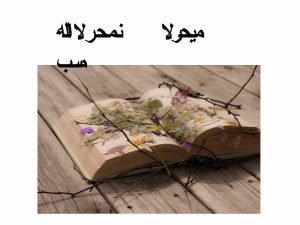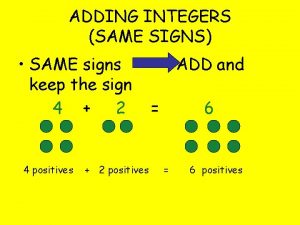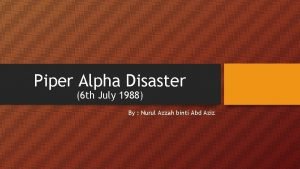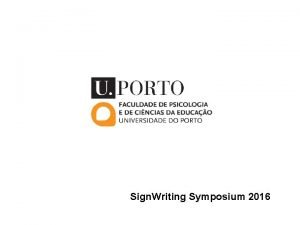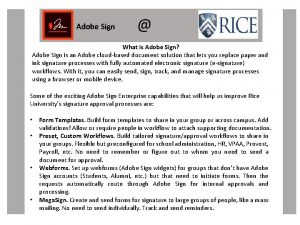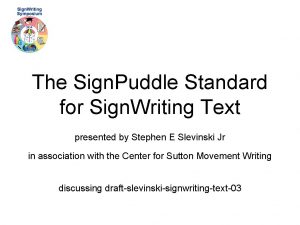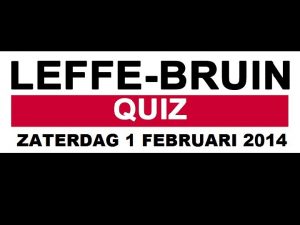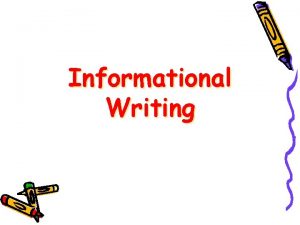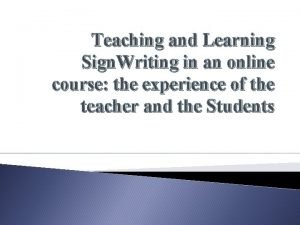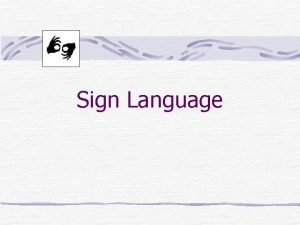Sign Writing Symposium 2014 Online July 21 24























- Slides: 23

Sign. Writing Symposium 2014 Online! July 21 -24, 2014 The Literacy Process of Brazilian and French Deaf Children Marianne Rossi Stumpf

L 1 (Sign Language) in Written form • The same cognitive and linguistic skills that are necessary for learning to read in the L 1 contribute to reading the L 2. - Learners who develop a high level of L 1 competence will be able to develop high level competence in additional languages. - Reading L 1 and L 2 increases metalinguistic skills, with the native language aiding the acquisition of and reading ability in the L 2. (Kayser, 2002).

Sign Language Acquisition 1. Theorical model proposed by Ferreiro and Teberosky fundamented by Piaget 2. Literacy is a construction of the learner not a givenknowledge. It happens in 3 stages: a) Distinction between drawing and writing b) Differentiation among the elements which compound writing (in this case the elementos composing the written sign) c) Establishment of correspondence between the Sign. Writing sign with each sign d) Graphic representation of thought and cognitive development

How deaf children take ownership of sign language? 1) Do deaf children take pleasure in learning sign writing? Does this acquisition enhance their main tool for construction of knowledge and integration into the world, which is SL? 2) How does the process of sign language ownership by deaf children take place? 3) Can deaf children, users of SL, evolve from acquision to literacy through the use of the Sign. Writing system?

Acquisition of sign language writing by deaf children Data collection involved children and tennagers in Brazil and in France

Experiments • Participants: 7 deaf children of the 2 nd grade at Escola de Ensino Fundamental Frei Pacifico (2003) • Duration 6 months – periods of 45 minutes twice a week • Total of 22 hours of work with the children Name Age 1. A 8 2. D 10 3. I 9 4. L 8 5. N 8 6. T 8 7. V 9

Drawing x Sign writing

Production from children learning writing through Sign. Writing system Sign for “bird” Sign for “house” and hand making house sign Sign for “eating” and drawing of plate Sign for “bird” With facial expression Sign for “wolf”

Sign for “football” Drawing of 2 nd finger Sign for “ball” Hand shapes and symbol of finger position using Sign. Writing In Sign. Writing

Learning Games with sign writing Domino game Memory game

Memory game Jogo de mímica

Diferentiation between elements composing the written sign Symbol of hand configuration Written signs

My participation in the LS-Script Project Activities: 1. Pre-school Director: Brigitte Garcia IRIT LIMSI IRIS Web. Sourd SFL 2. Primary school 3. Elementary school 4. Teachers of LSF – Research Institute of the Implications of Sign Language(IRIS) 5. Master and Ph. D studends (Université Paul Sabatier – Toulouse, Université Paris 8 and Université de Poitiers) 6. Teachers of deaf children at two schools in. Toulouse 7. Team of linguists at Université Paris 8 8. Professionals (teachers, interpreters and staff ) of the Shool and Association in Poitiers 9. Deaf Association. Tolosa 31

Sign. Writing activities in Toulouse Bilingual Schools

Symbol of hand configuration “second finger” Sign for “you” 1 deaf child – 5 years old Sign for “no”

Reading Practice

Written expression of signs after 5 and 6 during sign writing

6 lesson learning how to write LSF In the school class


The Correspondence

Some considerations: • In the experiments performed, Sign. Writingacquisition seems to bear relation to the great stages of literacy in oral language. • The affection aspect appears in the relatioship the child establishes with the object of knowledge, with the classmates and teacher, resulting in feelings of elevated selfesteem. • They quickly acquire the writing system and evolve in their learning.

Conclusions: • As a symbolic instrument, sign writing can be the fundamental cognitive support that the deaf are missing in order to turn their education into a rational and effective process. • Sign. Writing writing can be a significant activity for the deaf as it is in perfect accordance with their • Information technologies can enable the evolution of the Sign. Writing system , making it easier for deaf people to read and write.

Main points about Sign. Writing • Sign. Writing helps separate signing from the body, and in so doing - supports metalinguistic awareness - helps with cognitive development - makes it easier for children to edit signing - helps children become aware of the difference between the SL and OL.
 All traffic signs and meanings
All traffic signs and meanings Trousseaus sign
Trousseaus sign Trousseus sign
Trousseus sign Hypermagnesemia causes
Hypermagnesemia causes Kernig sign
Kernig sign Adding same signs
Adding same signs Sign up sheets online
Sign up sheets online The mysteries of harris burdick a strange day in july
The mysteries of harris burdick a strange day in july The mysteries of harris burdick captain tory
The mysteries of harris burdick captain tory July 1-4 1863
July 1-4 1863 Tender mean
Tender mean Criciúma ec
Criciúma ec 2001 july 15
2001 july 15 2003 july 17
2003 july 17 July 30 2009 nasa
July 30 2009 nasa Sources nso july frenchhowell neill technology...
Sources nso july frenchhowell neill technology... What is the significance of july 4 1776 brainpop
What is the significance of july 4 1776 brainpop Sylvia plath poppies in july
Sylvia plath poppies in july The cuban melodrama
The cuban melodrama Imagery in poppies in july
Imagery in poppies in july July 10 1856
July 10 1856 Ctdssmap payment schedule july 2021
Ctdssmap payment schedule july 2021 July 1969
July 1969 6th july 1988
6th july 1988


